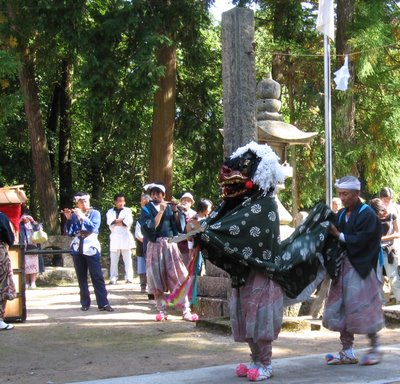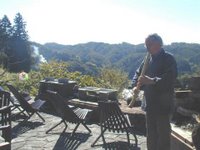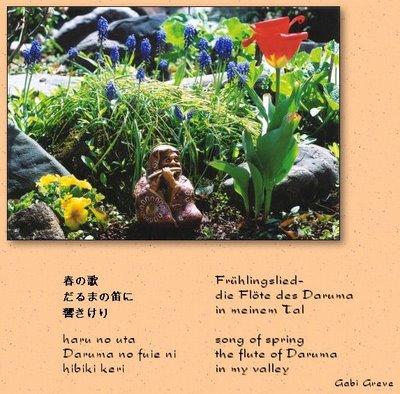:::::::::::::::::::::::::::::::::::::::::::::::::::::::::::::::::::::::::::::::::::::::::::::::::::::
Flute (fue, yokobue)
***** Location: Japan, worldwide
***** Season: See below
***** Category: Humanity
*****************************
Explanation
The flute, together with the drum, is an essential instrument for the "band" of any festival (matsuri) in Japan.

Lion Dance and Flute Players,
Ichi no Miya Shrine of my village in Okayama,
Autumn Festival 2006
© Photo Gabi Greve
Playing the flute has also been a means for lovers to communicate.
:::::::::::::::::::::::::::::::::::::::::::::::::::::::::::::::::::::::::::::::::::::::::::::::::::::
Shakuhachi, the Bamboo Flute 尺八
by Gabi Greve
shakuhachi ya
the sound of autumn
in my valley

Shakuhachi Concert at GokuRakuAn, Gabi Greve
.................................................
On the occasion of the Death of Inido Sensei
Winter 1938
One note of the shakuhachi
resounds endlessly
piercing the winter clouds.
Soen Nakagawa (1907-1984)
:::::::::::::::::::::::::::::::::::::::::::::::::::::::::::::::::::::::::::::::::::::::::::::::::::::

ryuuteki 龍笛 "dragon flute"
quote
a Japanese transverse fue made of bamboo. It is used in gagaku, the Shinto classical music associated with Japan's imperial court. The sound of the ryūteki is said to represent the dragons which ascend the skies between the heavenly lights (represented by the shō) and the people of the earth (represented by the hichiriki). The ryūteki is one of the three flutes used in gagaku, in particular to play songs of Chinese style. The pitch is lower than that of the komabue and higher than that of the kagurabue.
The ryūteki is held horizontally, has seven holes, and has a length of 40 centimeters and an inner diameter of 1.3 centimeters. Unlike the western flute, the holes are not covered by the fingertips, rather, the fleshy part of the finger is used. This allows for better control of "half-holing" techniques and chromatic notes, by simply raising the finger slightly above the holes.
Since the late 20th century, a few ryūteki players have begun to specialize in the performance of new music. One such performer is Takeshi Sasamoto.
© More in the WIKIPEDIA !
Origin of Japanese Flutes !!!!!
雅楽 平調 越天楽 龍笛独奏
DRAGON FLUTE SOLO
source : www.youtube.com
dragon flute -
sound of the silk road
sound of the past
Gabi Greve
:::::::::::::::::::::::::::::::::::::::::::::::::::::::::::::::::::::::::::::::::::::::::::::::::::::
Tougi Hideki, Toogi Hideki 東儀秀樹 Togi Hideki
(1959 - )
famous gagaku flute player
http://www.togihideki.net/
quote
Hideki Togi was born into one of the very few select, noble families that for centuries have safeguarded the 1,300-year-old musical tradition of gagaku, or Imperial Court music. Having spent his childhood in Thailand and Mexico due to his father's business affairs, Togi was exposed to different styles of music from The Beatles to rock to classical to jazz.
After graduating from high school he worked in the Imperial Music Division for ten years, becoming a master of all the exotic instruments that give his music its eerie beauty and depth. These include his favorites - the wind instrument called hichiriki, and biwa, a four-string Japanese lute. Naturally, he is also versed in the singing and dancing associated with the performing of gagaku.
source : japansclassic.com
Togi san was in Shirakawa Town 白河市, December 2011.

白河高校吹奏楽部 The High School Music Group, Shirakawa
. 「きらり!えん旅」 NHK Kirari Entabi .
*****************************
Worldwide use
Yemen
. Al Khallool flute .
al khallol
*****************************
Things found on the way
Warlord Takeda Shingen and the Flute Player
In 1573, one of Takeda’s armies had laid siege to Noda Castle in Mikawa. This fortress was defended by the forces of Togugawa Ieyasu, an ally of Oda Nobunaga. Shingen diligently followed the intelligence reports of the siege with the intent of determining the rate of deterioration the besieged defenders. The intelligence made mention of a lone flute player who could be heard playing within the castle walls every evening. According to tradition, Shingen reasoned that he could determine the moral level of the defenders by assessing the quality of the flute music!
Each night one of the Noda garrison played a flute, which captivated some of the Takeda soldiers and none more so than Shingen himself who was particular taken by its haunting melody. In order to hear the flute more clearly he moved closer to the ramparts and was spotted by a sniper who shot him. Grievously wounded Shingen departed from the battle and urged his followers to keep his death secret for as long as possible because the clan had been built upon his legendary shoulders and he feared that it would quickly fall apart if news of his death spread. In the days that followed his conditioned worsened and he died.
Takeda Shingen 1521-1573
:::::::::::::::::::::::::::::::::::::::::::::::::::::::::::::::::::::::::::::::::::::::::::::::::::::
Musical Instruments of Japan
Drums uses in Buddhist Rituals
by Gabi Greve
*****************************
HAIKU
kigo for the New Year
fukizome 籟初 (ふきぞめ) first blowing
(of the flute or other pipe instruments)
..... fukizome 吹初(ふきぞめ)
..... fukihajime, fuki hajime 吹始(ふきはじめ)
籟 RAI, is an old type of flute with three holes.
In olden times, flutes were made from bamboo, later from wood and lately also from metal (furuuto フルート ).
. SAIJIKI - THE NEW YEAR
:::::::::::::::::::::::::::::::::::::::::::::::::::::::::::::::::::::::::::::::::::::::::::::::::::::
春の歌 だるまの笛に 響きけり

song of spring -
the flute of Daruma
in my valley
Gabi Greve, Haigaonline Issue 6
:::::::::::::::::::::::::::::::::::::::::::::::::::::::::::::::::::::::::::::::::::::::::::::::::::::
五月雨の里やいつ迄笛法度
samidare no sato ya itsu made fue hatto
Fifth Month rain--
in the town how long
this flute ban?
Issa and more haiku about the FLUTE
According to the editors of Issa zenshû, this haiku refers to a law prohibiting the playing of flutes. Issa, perhaps bored by the constant rain, seems to long for a distraction. See Issa zenshû (Nagano: Shinano Mainichi Shimbunsha, 1976-79) 2.211, note 6. "Fifth Month rain" (samidare) pertains to the old lunar calendar; it would be June rain in the present calendar. Shinji Ogawa observes, "In the modern Japanese sense, May weather consists of mostly fair days, not cold, not hot, in the best season of the year.
Therefore, May rain is very pleasant in modern Japanese sense. On the other hand, samidare (May rain in old Japanese), is the June rain that falls day after day, creating high humidity and helping mold to grow in the corners of the house."
Sakuo Nakamura pictures the following: "Gloomy rain keeps falling for a long time. We are very much disgusted. To play the flute in the town has been banned for a long period. This adds to our boredom."
David Lanoue
.............................................................................
笛吹て山のかがしの御礼哉
fue fuite yama no kagashi no orei kana
playing the flute
to say "thank you"
to the mountain scarecrows
Tr. Gabi Greve
At the night of O-Bon in 1810.
:::::::::::::::::::::::::::::::::::::::::::::::::::::::::::::::::::::::::::::::::::::::::::::::::::::
lightning showers~
lonely beggar plays
the bamboo flute
yellow violas
raaga basant on flute
a pink butterfly
Narayanan Raghunathan, India
xxxxxxxxxxxxxxxxxxxxxxxxxxxxx
fluttering down
a cadence --
the softness of flutes
Chris Eichenberger, Simply Haiku Forum
xxxxxxxxxxxxxxxxxxxxxxxxxxxxx
a chevron of mountains peek through mist
-- bamboo flute
"chibi" (pen-name for Dennis M. Holmes)
xxxxxxxxxxxxxxxxxxxxxxxxxxxxx
bamboo flute -
the blind monk plays
with the autumn winds
Gabi Greve
Zen Master Ikkyu and the Bamboo Flute
:::::::::::::::::::::::::::::::::::::::::::::::::::::::::::::::::::::::::::::::::::::::::::::::::::::
. Matsuo Basho 松尾芭蕉 - Archives of the WKD .
須磨寺やふかぬ笛きく木下やみ
Sumadera ya fukanu fue kiku koshita yami
temple Sumadera -
I listen to the flute nobody plays
in the darkness under the trees
Tr. Gabi Greve

In memory of Taira no Atsumori 平敦盛 (1169 - 1184) and his flute now kept at the temple.
Samurai had to learn all kinds of aristocratic things to be able to please their masters.
Atsumori was famous for his flute playing, aoba no fue 青葉の笛.

- - - - -
Suma Temple -
hearing a silent flute
under dark trees
Suma temple is one of the oldest temples in the Kobe area and still very popular with worshipers. It belongs to Shingon Buddhism and is dedicated to Kannon, the Goddess of Mercy. The extensive grounds are full to the brim with monuments, from haiku stones to quaint Buddhas and Jizos, modern memorials and statues.
Copyright © 2003-2006
Ad G. Blankestijn, Japan.
Station 42 - Ironohama Discussion
"The Narrow Road to the Deep North"
. Matsuo Basho at temple Sumadera 須磨寺
. Taira no Atsumori 平敦盛 - Introduction .
... ... ...
Paul Muldoon, Basho and the Temple Sumadera
© by William J. Higginson
The following poems appear in “Hopewell Haiku” (published in Hay, 1998; the sequence also appeared as a chapbook the previous year). “Hopewell” refers to the New Jersey town where Muldoon lived for a time. I take the poems out of order for the sake of this discussion.
A bullfrog sumo
stares into his bowl of wine.
Those years in Suma.
“Those years in Suma” refers to the time Prince Genji, of Genji monogatari, was exiled from the capital at Kyoto. The passage in the life of the fictional prince aptly encapsulates the feelings of desperation associated with Suma from its use as a place of exile for actual nobles whom various governments literally “wanted out of the way.” (Execution was not generally a punishment for nobles in Heian Japan, who were more painfully punished by such banishments.) It also reminds me of Bashô’s verse written at the Buddhist temple there:
sumadera ya fukanu fue kiku koshita yami
Suma Temple . . .
I hear the unblown flute
in the shade of a tree
In the real war almost two hundred years after The Tale of Genji, the war epically recorded in The Tale of the Heike, the young Taira general Atsumori was killed by a Minamoto warrior named Noazane, near Suma. Noazane, father of a warrior son the same age as his victim, then discovered on Atsumori’s body a flute, and, reflecting on the insanity of a world in which such killing takes place, he became a Buddhist monk to pray for Atsumori’s spirit. That “Green-Leaf Flute” remains a treasure of Suma Temple to this day.
(The temple was founded in 786, some 400 years before the war and 900 years before Bashô’s visit.)
Bashô plays with the tradition of sadness, isolation, death, and giving up the world at Suma, making the sound of the unplayed flute a metaphor for Zen koans (on silent flutes, clapping, and so on) that lightly dissolves into the pleasant shade of a tree under summer’s sun in this desolate place. But note how that shade suggests again the “Green-Leaf Flute”—and the death of Atsumori. Light as the last line of Bashô’s poem may seem on first reading, it grows deeper with the next.
Muldoon’s poem, in contrast, begins with the humorous overlay of a metaphorical bullfrog characterizing a sumo wrestler, shifts the wrestler into an inner, personal loneliness, then deepens that mood with the Genji reference, and finally comes round to humor again as it ends in the feminine slant-rime “sumo/Suma.” Bashô’s “haikai twist” involves the dissolution of loneliness and intimations of mortality into a pleasant physical comfort, but subtly reminds us again of the vanity of this world. Muldoon’s changes involve a full-circle progression that begins and ends with humor encapsulating a dark night of the soul. Bashô would bow to such craft put to the service of exploring the range of human emotion and the interactions of place and cultural memory.
Read the full essay here:
A Poet's Haiku: Paul Muldoon
:::::::::::::::::::::::::::::::::::::::::::::::::::::::::::::::::::::::::::::::::::::::::::::::::::::
© Two Haiga by Emile Molhuysen, Delft, 2007


*****************************
Related words
***** Lampionflower flute (hoozukibue)
kigo for autumn
***** Voices of Animals in Haiku
river frog's flute (kajikabue 河鹿笛)
kigo for all summer
"deer flute", deer caller (shikabue 鹿笛)
kigo for all autumn
:::::::::::::::::::::::::::::::::::::::::::::::::::::::::::::::::::::::::::::::::::::::::::::::::::::
toy flutes and lures as kigo for spring
uguisubue 鶯笛 (うぐいすぶえ) nightingale flute
hibaribue 雲雀笛 (ひばりぶえ) lark flute
komabue 駒鳥笛 (こまぶえ) redbreast flute, robin flute
kijibue 雉笛 (きじぶえ) pheasant flute, pheasant whistle
. Folk Toys with whistles .
hatobue 鳩笛 pidgeon whistle, pidgeon flute
:::::::::::::::::::::::::::::::::::::::::::::::::::::::::::::::::::::::::::::::::::::::::::::::::::::
kigo for all summer

kusabue 草笛 (くさぶえ) "reed flute"
kusabue fuku 草笛吹く(くさぶえふく)blowing notes on a reed flute
..... kusabue narasu 草笛鳴らす(くさぶえならす)
people also blow melodies on blades of grass or leaves.
mugibue 麦笛 (むぎぶえ) "straw flute"
mugiwarabue 麦藁笛(むぎわらぶえ)
..... mugiwarabue 麦稈笛(むぎわらぶえ)
Straw (wara) and related KIGO
:::::::::::::::::::::::::::::::::::::::::::::::::::::::::::::::::::::::::::::::::::::::::::::::::::::
External LINK about Japanese Flutes
http://www.asahi-net.or.jp/~DL1S-YMGC/index-e.htm
:::::::::::::::::::::::::::::::::::::::::::::::::::::::::::::::::::::::::::::::::::::::::::::::::::::
[ . BACK to WORLDKIGO TOP . ]
[ . BACK to DARUMA MUSEUM TOP . ]
:::::::::::::::::::::::::::::::::::::::::::::::::::::::::::::::::::::::::::::::::::::::::::::::::::::






5 comments:
フルートの音の中から春の人フルートの音の中から春の人
furûto no oto no naka kara haru no hito
from a sound
of the flute
a spring person
九鬼あきゑ . Akie Kuki
Tr. Fay Aoyagi
silent birds ~
the flute’s voice goes south
in winter
Elaine Andre
'Aoba no fue': The name of an ancient flute
aoba no fue 青葉の笛 flute with green leaves
aobabue 青葉笛flute with green bamboo leaves
It was a flute of the monsters 鬼笛 onibue
Hakuga no Sanmi 博雅三位
received a flute from the Monsters of the Suzakumon gate.
Joozoo< Jōzō 浄蔵 Jozo
(891 - December 27, 964) played the flute.
.
草笛に吹くよ別子の銅山節
kusabue ni fuku yo Besshi no doozanbushi
blowing it
on a reed flute -
the Besshi Copper Mine Song
品川鈴子 Shinagawa Suzuko
The Besshi copper mine (別子銅山 Besshi dōzan)
http://edoflourishing.blogspot.jp/2015/12/sumitomo-family-business.html
.
Taira no Atsumori 平敦盛
(1169 - 1184)
and Ikuta Jinja Kobe
.
http://darumapedia-persons.blogspot.jp/2017/11/taira-no-atsumori.html
.
Post a Comment